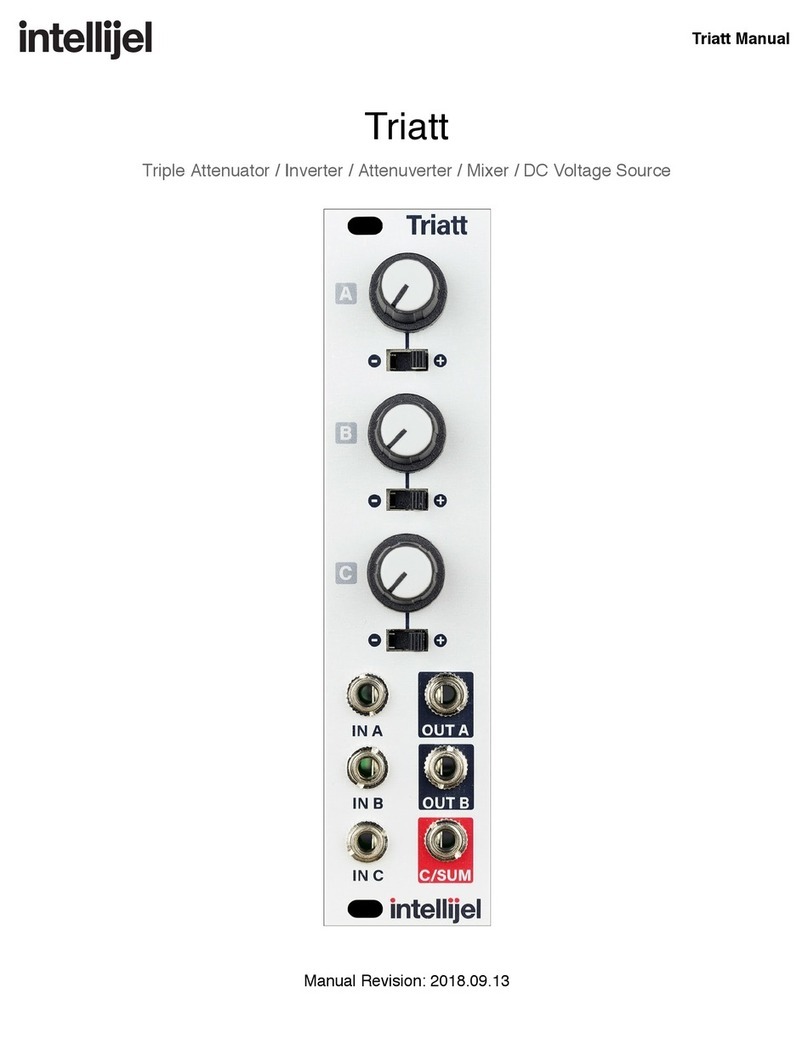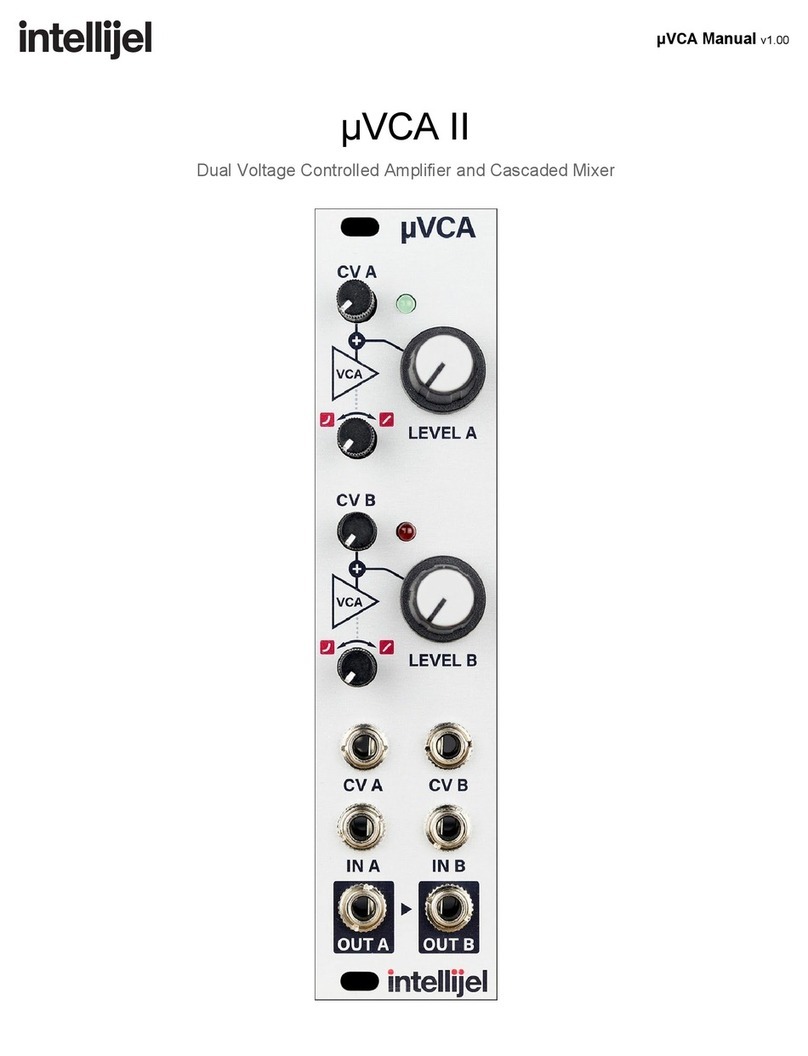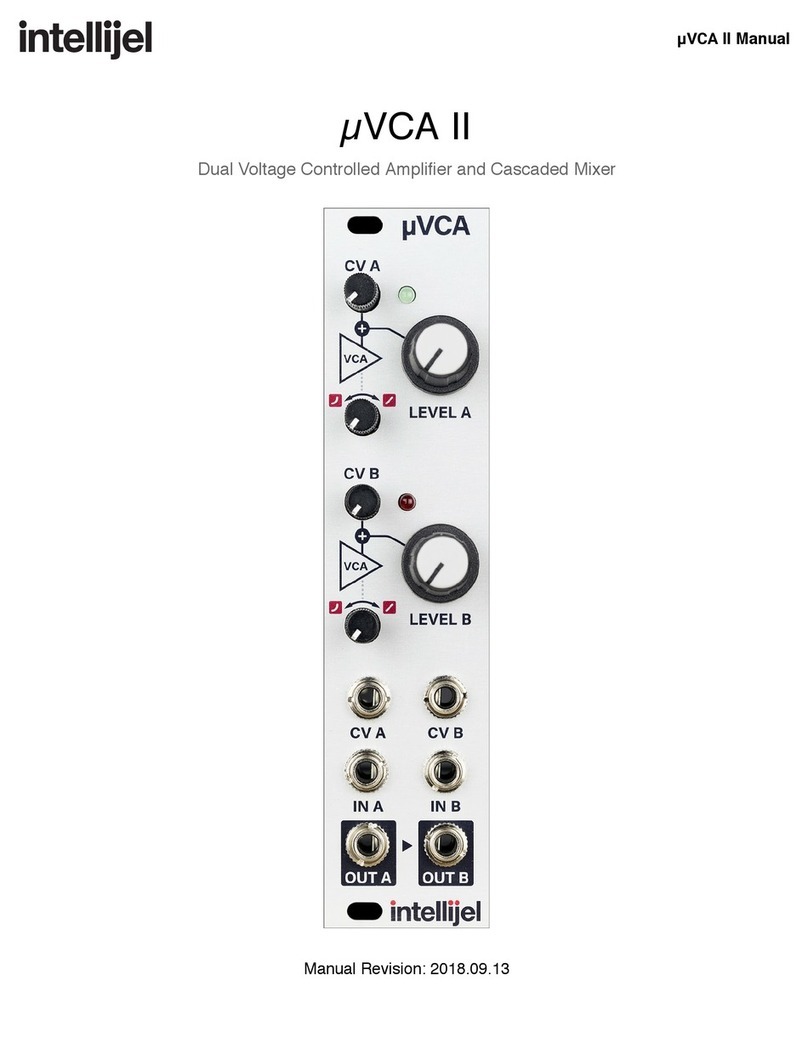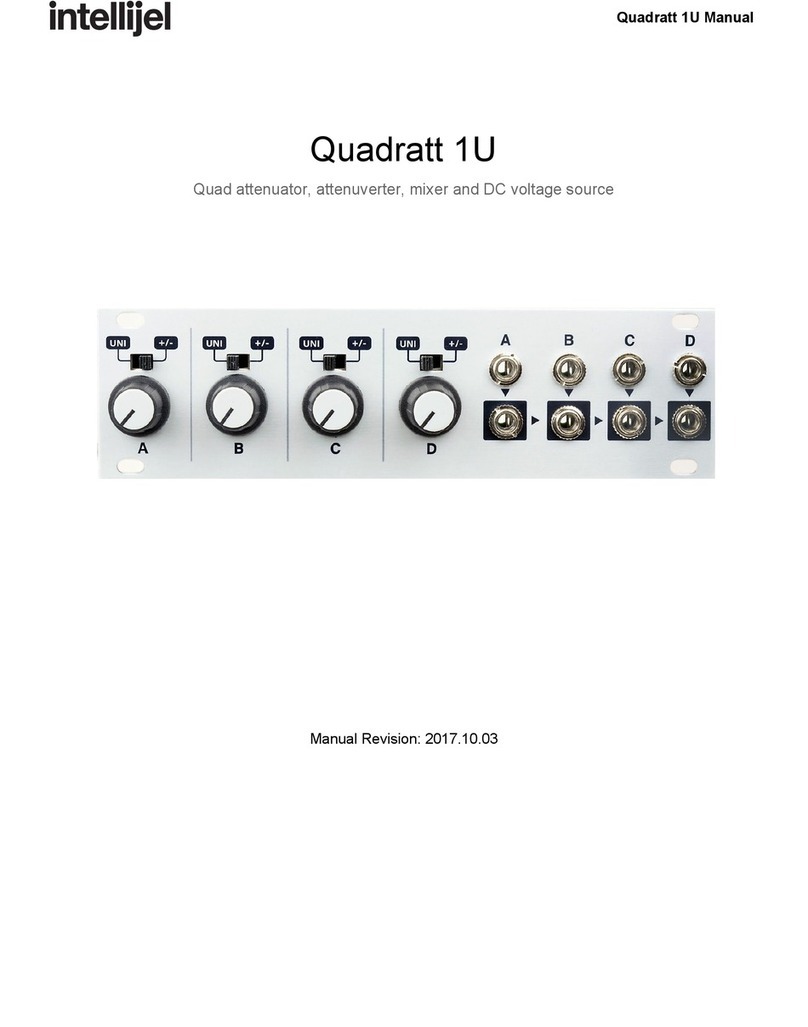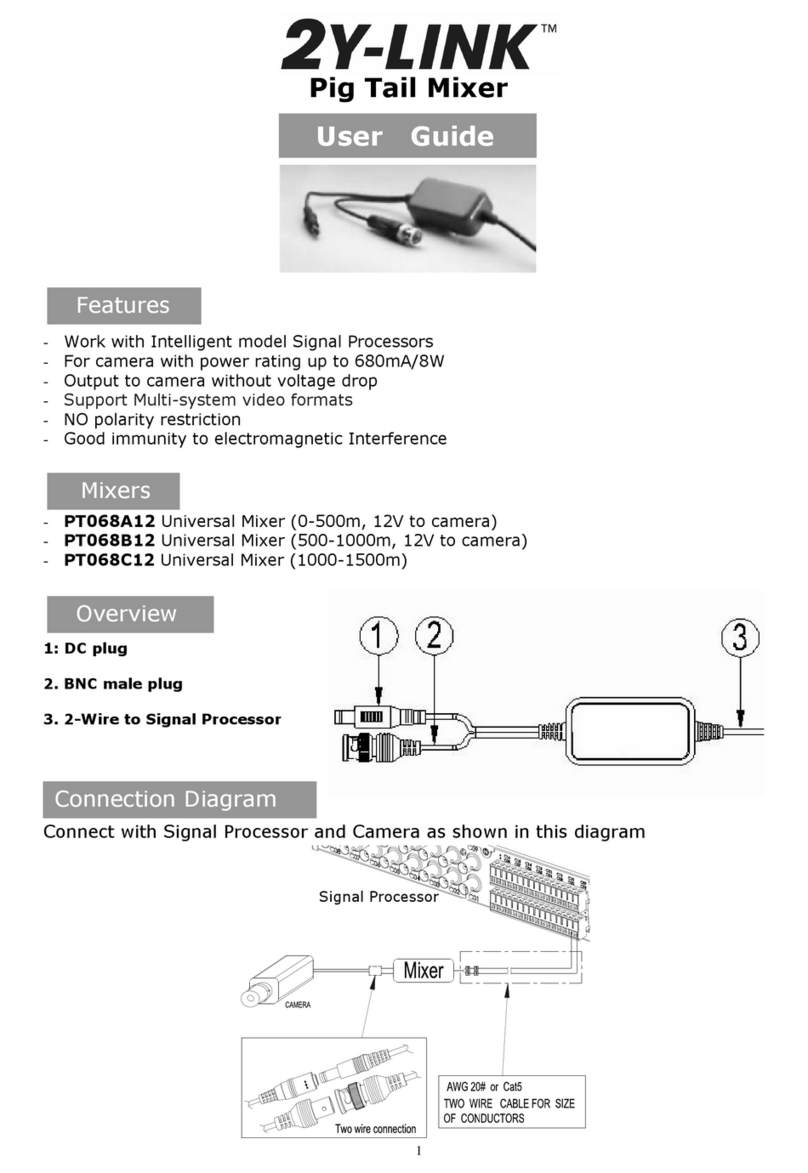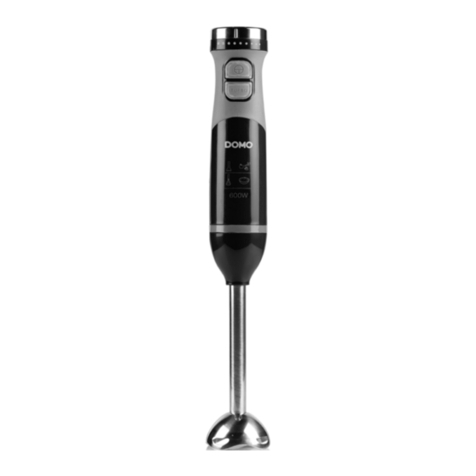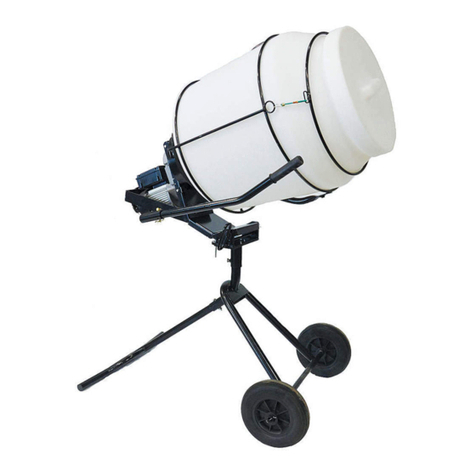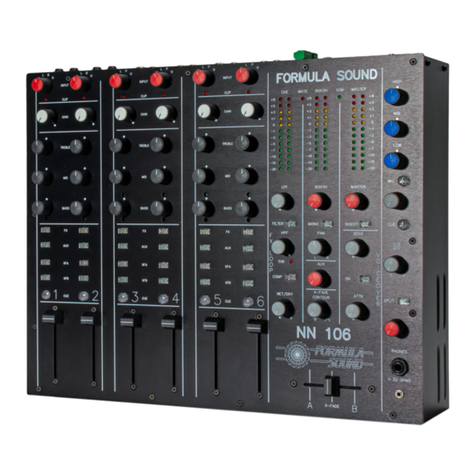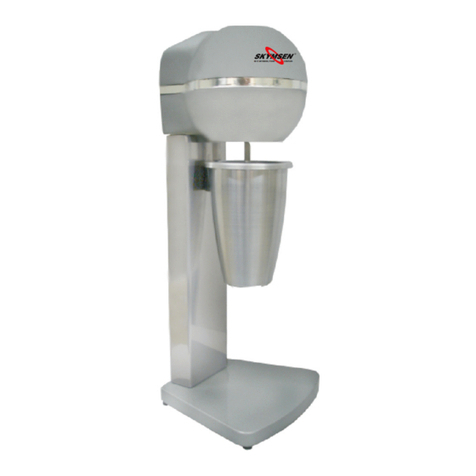Intellijel Linix User manual

Linix Manual v1.00
Linix
Six Channel Voltage Controlled Amplifier / Five Channel Mixer

Linix Manual v1.00
Table of Contents
Table of Contents
Overview
Features
Installation
Before Your Start
Installing Your Module
Front Panel
Controls
Inputs and Outputs
Instructions
Technical Specifications
Page 1

Linix Manual v1.00
Overview
Linix is the successor to the now discontinued HexVCA module. It comprises six high quality
linear VCA circuits with CV attenuation and BIAS control for each channel. The first five
channels normal to a summing amp that feeds the input of sixth channel. This allows you to
have voltage control of the master sum. Patching into an individual output channel breaks that
channel from the master sum. If the direct output is used for each channel then the sixth
channel becomes an additional independent VCA as well (Hex VCA). Each channel has an LED
to monitor incoming CV activity.
The SUM output has an additional set of LEDs to monitor the bipolar state of the final sum and a
clip led to monitor the absolute max signal level.
There is a 12pin header on the back to connect the Linix channel direct outputs to the inputs of
an Intellijel Mutamix or Mutagen module.
Features
●Manual BIAS control per VCA which is convenient when using the module as a mixer or
for biasing when CV modulating the VCA with a bipolar LFO.
●Dedicated CV attenuators with LEDs for monitoring CV signals.
●Channel six provides a sum of all input signals and CV inputs.
●Using individual outputs removes a channel from the sum.
Page 2

Linix Manual v1.00
Installation
Intellijel Eurorack modules are designed to be used with a Eurorack-compatible case and power
supply.
Before Your Start
Before installing a new module in your case you must ensure your case’s power supply has
sufficient available capacity to power the module:
● Sum up the specified +12V current draw for all modules, including the new one. Do the
same for the -12 V and +5V current draw. The current draw will be specified in the
manufacturer's technical specifications for each module.
● Compare each of the sums to specifications for your case’s power supply.
● Only proceed with installation if none of the values exceeds the power supply’s
specifications. Otherwise you must remove modules to free up capacity or upgrade your
power supply.
You will also need to ensure you have enough free space (hp) as well as free power headers in
your case to fit the new module.
You can use a tool like ModularGrid to assist in your planning. Failure to adequately power your
modules may result in damage to your modules or power supply. If you are unsure, please
contact us before proceeding.
Installing Your Module
When installing or removing a module from your case always turn off the power to the case and
disconnect the power cable. Failure to do so may result in serious injury or equipment damage.
Ensure the 10-pin connector on the power cable is connected correctly to the module before
proceeding. The red stripe on the cable must line up with the -12V pins on the module’s power
connector. The pins are indicated with the label -12V, a white stripe next to the connector, the
words “red stripe”, or some combination of those indicators.
Page 3

Linix Manual v1.00
Most modules will come with the cable already connected but it is good to double check the
orientation. Be aware that some modules may have headers that serve other purposes so
ensure the cable is connected to the right one.
The other end of the cable, with a 16-pin connector, connects to the power bus board of your
Eurorack case. Ensure the red stripe on the cable lines up with the -12V pins on the bus board.
On Intellijel power supplies the pins are labelled with the label “-12V” and a thick white stripe:
If you are using another manufacturer’s power supply, check their documentation for
instructions.
Page 4

Linix Manual v1.00
Once connected, the cabling between the module and power supply should resemble the
picture below:
Before reconnecting power and turning on your modular system, double check that the ribbon
cable is fully seated on both ends and that all the pins are correctly aligned. If the pins are
misaligned in any direction or the ribbon is backwards you can cause damage to your module,
power supply, or other modules.
After you have confirmed all the connections, you can reconnect the power cable and turn on
your modular system. You should immediately check that all your modules have powered on
and are functioning correctly. If you notice any anomalies, turn your system off right away and
check your cabling again for mistakes.
Page 5

Linix Manual v1.00
Front Panel
Page 6

Linix Manual v1.00
Controls
1. BIAS 1-5 - Sets the base level, or bias, of a channel’s VCA. When fully clockwise this
approximately equivalent to applying a +5 V voltage at the CV input resulting in unity
(1:1) gain. The knob level is summed with the channel’s CV input.
2. BIAS SUM - Sets the base level of channel 6, or the sum of all channels with no
connection to their OUT jacks.
3. CV Attenuators - Controls the amount of CV sent to control a channel’s level
Inputs and Outputs
A. CV 1-5 - The CV input for controlling the level of a channel. A +5 V input with the
channel’s attenuator fully clockwise and BIAS control fully counterclockwise results in
approximately unity (1:1) gain.
B. CV SUM - The CV input for controlling the level of all summed channels. Connecting a
channel’s OUT removes it from the SUM and if all channels are removed, the SUM
channel can be used as a sixth VCA.
C. IN 1-5 - The input to a channel.
D. IN SUM - This inputs a signal into the summed mix. Since the BIAS SUM knob controls
the level of the summed mix, this will only control the input of this channel relative to the
summed mix. If the OUT of each channel is connected, this input will function like any
other channel with the BIAS knob controlling the base level of channel 6.
E. OUT 1-5 - The signal output for a channel.
F. SUM - The signal output for the summed mix of all channels without a connection to their
OUT jack.
Page 7

Linix Manual v1.00
Instructions
Six Independent VCAs
The simplest way to use the Linix is to ignore any of the summing CV and mixing functionality
and just use it as up to six independent VCAs:
● Connect the output signal from the source to IN 1. The source can be anything, any
oscillator, LFO, envelope, or any other audio or CV generator.
● Connect OUT 1 to the input of the destination.
● Connect a modulating signal to CV 1. The modulating signal can also be anything but is
typically the output of an envelope generator or LFO. Interesting effects can be had
when using audio-rate sources like oscillators.
● Turn BIAS 1 fully counterclockwise to remove any CV bias.
● Adjust the CV input attenuator and Linear / Exponential Response control to taste.
You can repeat the above instructions for all other channels to get six totally separate VCAs.
Level Bias
The BIAS control of each channel can be used to bias, or set a base level for the channel’s
response. In this way you can set the “default” amount of signal passing through the VCA, and
then adjust it using external CV. One situation where this is useful is when controlling amounts
of modulation. For example when the output of one oscillator is being connected to the FM input
of another, the Linix can be used to vary the FM amount:
● Connect the sine output of oscillator 1 (the modulator) to IN 1 of the Linix.
● Connect OUT 1 of the Linix to the FM input of oscillator 2 (the carrier).
● Use BIAS 1 to set the FM amount (index).
● Connect an envelope to CV 1 and adjust the attenuator. The envelope can now be used
to vary the FM index during each note played.
Summed Mixing
The inputs of the Linix have a summing feature, allowing it to be used as a mixer:
● Connect up to five sources to IN 1 through IN 5.
● Take the output from the SUM jack.
Page 8

Linix Manual v1.00
● LEVEL 1 through LEVEL 5 control the mix levels.
● You do not need to connect anything to CV 1 through CV SUM if you are using the
module as a manually controlled mixer, but they can be used to automate the mix on one
or more channels, or to control the level of the overall mix with CV SUM.
These various methods of using the Linix can be combined. You can use summed mixing on
channels 1-4 and then use channel 5 as an independent VCA by using its output to remove it
from the SUM mix, and many other combinations. This is why the Linix is more versatile than
your average VCA!
Rear Jumpers
LINK - This header on the back of the module allows the connection of a Mutamix using a
12-pin ribbon cable. Connecting the two modules normals the outputs of the Linix to the inputs
of the Mutamix. Connecting cables to the Linix outputs will not break this normalling. However,
connecting signals to the Mutamix inputs will break this normalling. This can be useful for
splitting a signal, for example to create a wet/dry mix. Note that because the Linix sums its
inputs to channel six, Mutamix will in turn receive the sum of all Linix signals on channel six.
Page 9

Linix Manual v1.00
Technical Specifications
Width
16 hp
Maximum Depth
28 mm
Current Draw
88 mA @ +12V
84 mA @ -12V
Page 10
Other manuals for Linix
1
Table of contents
Other Intellijel Mixer manuals

